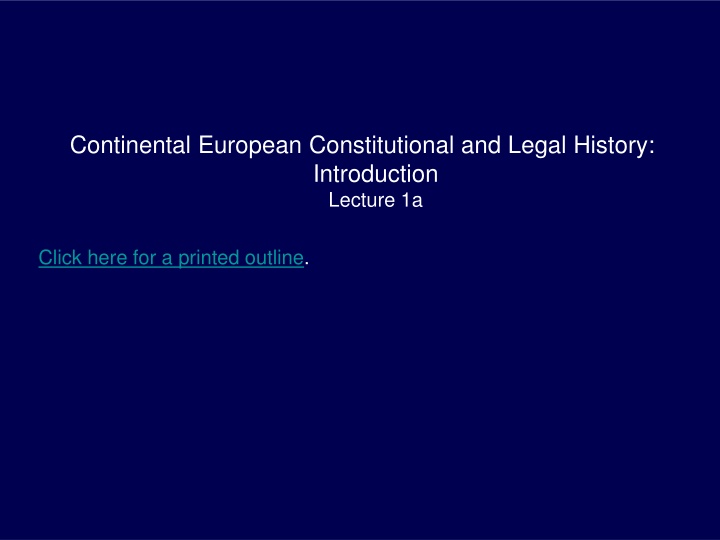
Continental European Constitutional and Legal History Overview
Explore the legal and constitutional history of Continental Europe from 450 AD to 1648, focusing on civil law, Western legal tradition, and key topics like marriage, property rights, and witnesses. Emphasizing the development of private law over public law, the course covers the influence of canon law and Roman law on legal systems. Dive into the evolution of law in France and other European regions, examining the relationship between law, politics, and society.
Download Presentation

Please find below an Image/Link to download the presentation.
The content on the website is provided AS IS for your information and personal use only. It may not be sold, licensed, or shared on other websites without obtaining consent from the author. If you encounter any issues during the download, it is possible that the publisher has removed the file from their server.
You are allowed to download the files provided on this website for personal or commercial use, subject to the condition that they are used lawfully. All files are the property of their respective owners.
The content on the website is provided AS IS for your information and personal use only. It may not be sold, licensed, or shared on other websites without obtaining consent from the author.
E N D
Presentation Transcript
Continental European Constitutional and Legal History: Introduction Lecture 1a Click here for a printed outline.
The Course Pur avoider le stuffing del rolls ove multip The legal and constitutional history of Continental Europe: the civil law and the Western legal tradition . Chronological range: 450 AD to 1648, with looks backward 400 years for the legacy of the ancient world and forward 250 more for the codifications on the Continent in the 19th century. Geographical range: all of Continental Europe with occasional glances at England. How to avoid superficiality? By testing our generalities against three particular topics: The formation of marriage The capture of wild animals as the foundation of property . \Witnesses in both criminal and civil procedure
The Course (contd) Pur avoider le stuffing del rolls ove multip The topics come from the three principal areas into which Europeans historically divided their law:: The law of persons (marriage) The law of things (wild animals). The law of actions (witnesses) The development of these topics comes from two different sources of law The formation of marriage (canon law) The capture of wild animals (Roman law) The law of witnesses (the product of canonists and Romanists working together) These are all topics of private law ( the law about the legal relationships between members of the community). There is no single topic about public law (the law that deals with the relationships between the governing authorities and the members of the community). We deal with public law when we talk about constitutional and institutional developments and when we talk about witnesses in criminal cases (a public-law topic).
The Course (contd) Pur avoider le stuffing del rolls ove multip Another way to avoid superficiality is by relating our generalities to one particular region when we reach the early modern period: France (with England, Italy, Germany, Spain, the Low Countries, giving examples for comparison and contrast) France because we can see it becoming a nation-state in our period France because it is close to England A third way to avoid superficiality is by checking our generalities against the documents in the coursepack. Two questions: How does the way people were thinking about law in each period proceed from what had gone before and lead to what was to come next (a largely diachronic question)? How does the way that people were thinking about law in each period relate to the broader political, social and intellectual developments in the period (a largely synchronic question)?
The Course (contd) Pur avoider le stuffing del rolls ove multip Two hour-and-a-half classes on Mon. and Wed. Discussions of prerecorded lectures and documents. A separate section for the undergraduates in the latter half of the week. For the details about the topics of the classes, the reading assignments, and the course requirements see the off-Canvas website.
What is this course about? law the English word is related to Old English licgan, not lecgan, i.e., lie not lay lex vs. ius: loi vs. droit; Gesetz vs. Recht; wet vs. recht; legge vs. diritto; ley vs. derecho. The former refers to a specific law, the latter to law in general and is also the word for right . The relationship of this distinction to the distinction between natural law and positive law, between the law that exists notionally in all times and places as opposed to the law adopted for a particular community. Gratian, Concordance of Discordant Canons, c. 1140: Mankind is ruled by two things, natural law and custom. The law of nature is what is contained in the Mosaic law and the Gospels, in which everyone is ordered to do to another what he wants done to himself and is prohibited from doing to another what he does not want done to himself.
What is this course about? (contd) Constitution The word is only beginning to be used in the sense of a body of fundamental law, a law about laws, at the end of our period in England. For our period, we are, for the most part, going to have try to discern what the fundamental law might have been by looking at documents that contemporaries did not label as constitutional in the modern sense, or at what seem to be unspoken assumptions about how the system ought to work. Quite a bit can be discerned from discussions about the relative powers of emperors, kings, and popes.
What is this course about? (contd) Civil law vs. common law In traditional comparative law terminology this is a course about Continental European civil law as opposed to English common law. Though the focus of this course is very much on the European Continent, the area that Anglo-American lawyers call the region of the civil law, we will do enough comparison to suggest that the differences between the Anglo-American and Continental European law tend to be exaggerated..
Periodization Much of European legal history is still written from a rather rigid national point of view. The periodization thus tends to be dictated by the periodizations of national histories. We are trying to do something different. Periodization is important in any kind of history, but it is also a problem, because the way we organize may predetermine how we come out, what our overall points will be. Look at the table on the next slide.
Periodization (contd) Period Description Politics Intellectual Roman Canon Customary/National 450 1100 Early Middle Ages: primitive collections Barbarian Invasions Monastic Romano- barbarian Codes Collections Barbarian Codes, Capitularies scholars 1100 1250 High Middle Ages: academic study Feudalism, Feudal monarchy Early scholasticism CJC glossators Gratian >decretists Papal decretals Custumals 1250 1500 Later Middle Ages: academic application: National monarchy Late CJC commentators, Consilia Decretalists >encyclopedic jurists Custumals and statutes scholasticism 1450 1550 Renaissance and Reformation: academic bifurcation Absolutism Humanists and reformers Humanist jurists Councils, Consilia Codification of custom, Reception 1550 1750 Early Modern: bureaucracy and philosophers Modern: codification Absolute monarchy Political theory; Natural law, usus modernus pandectarum Pandectists >Codification Papal bureaucracy, Handbooks Institutes and statutes Mathematics 1700 1917 Revolution Enlightenment, Pandectists, Historical School Modern decretalists >Codification Codification
Periodization (contd) We can organize the material: By events or even political periods. May overemphasize the political. By intellectual centers. May overemphasize the intellectual. By formal sources of law. May be too diachronic. We can try to create a matrix of all three.
Periodization (contd) Some tag phrases with which to begin: 450 1100 1250 1500 age of academic application 1450 1550 age of academic bifurcation 1550 1750 age of bureaucracy and philosophers 1750 1917 age of codification age of the primitive collections In all these ages except perhaps for the 1550 1750 period there was a close parallel between the canon law developments and the Roman and some with the customary/national. The absence of a social, economic, or cultural column is troublesome.
Periodization (contd): Roman legal history Period Description Politics Sources of Law 500-250 BC Archaic City-State XII Tables 250-1 BC Pre-Classical Urban Empire Statutes/Cases 1-250 AD Classical Principate Cases 250-500 AD Post-Classical Dominate Imperial Constitutions 550 AD Justinian Byzantine Code
Periodization (contd): Roman legal history There is a quite tight, almost definitional relationship between the type of politics and the sources of law. It turns out, that there is also a quite tight relationship between types of procedure and politics and sources of law. Archaic procedure is highly formal; much depends on the consent of the parties; the power of the state is weak. With the elaboration of the law in the pre-classical and early classical periods, the procedure became more flexible but was still heavily dependent on the will of the parties. As the empire became more bureaucratic, state officials came to play a more important role in the procedure and appeal to the emperor rather than elaboration by jurists became the most important source of law. Some people have seen in this development a paradigm of all legal history. The sketch of European legal history that we just looked at (except for the end) suggests that in some sense Roman legal history repeated itself in medieval and early modern Europe. That may or may not be right.
Periodization (contd): English legal history Period Description Politics Sources of Law Roman Influence Continent Compare 600-1150 Age of Tort Tribal >Feudal Monarchy Feudal monarchy Barbarian Codes, Custom Non-existent Weak 1150-1300 Age of Property Custom, Case Law, Statute Strong on Method Same 1300-1500 Age of Trespass National monarchy Case Law Weak Strong 1500-1700 Age of Equity Absolute Monarchy > Const. Monarchy Case Law, Statute Strong in spots Quite strong 1700-2000 Age of Reform Const. monarchy, Parliamentary Sovereignty Case law, Statute, Some Codification Submerged but there Quite strong Note: When the outline says some codification in the modern period, it is referring to the fact in England (and generally in the Anglo-American legal world) commercial law (e.g., the Uniform Commercial Code in the U.S.), criminal law, civil and criminal procedure, and public law more generally are largely codified. There are, however, relatively few codes of private law that are so characteristic of the Continent.
Periodization (contd): English legal history The periodization of English history has remarkable parallels with that of the Continent. The political and constitutional developments in most of the periods are similar. The English, I would argue, have a tendency to exaggerate the differences in these departments. Whether they also have a tendency to exaggerate the differences in legal development is more problematic. What the outline shows is that the influence of Roman law on English legal thought has varied over time. It was quite strong in High Middle Ages, quite weak in the later Middle Ages. That led to a situation, when knowledge of Roman law and Continental developments returned in the early modern and modern periods, where the English (and the Anglo-American) legal systems can better be described as cousins of the Continental rather than as siblings.
The codification phenomenon At the beginning: literacy the beginnings of a realization that law belongs in separate category realization of the connection between what we would call the state, and what they called different things, and the law At the end: a long period of professional development sources of law proliferating and becoming unmanageable person of power and/or genius
The codification phenomenon (contd) Taking Justinian, the Napoleonic Code, and the Uniform Commercial Code as examples of end-codifications , the differences may be more important than the similarities: Justinian is a collection of texts, the Napoleonic Code and Uniform Commercial Code are systematic rewritings of the law. The politics seem to be similar between Justinian and Napoleon but not Karl Llewelyn, the drafter of the UCC. Justinian is legally conservative; Napoleon and Llewelyn are much less so.
The codification phenomenon (contd) True codes , i.e., codes that follow the model of the 19th European codes, are: authoritative exclusive systematic Applying these tests there is no Western code as opposed to a collection before the Prussian Civil Code of 1794; this is followed by the Napoleonic code of 1804, and by the Austrian Civil Code of 1811 (1st ed. 1786). Once these three codes had been promulgated, the ones that followed showed a considerable amount of influence from them, particularly from the French code.
Conclusion At the end of the table above for Roman law, we have the great Roman collections: 529 533 A.D. They are going to become very important in our story. We ll talk about them in the next class. In the rest of this class I would like to talk about another legacy of the ancient world: Christianity, beginning with a document: Paul s letter to the Romans.





